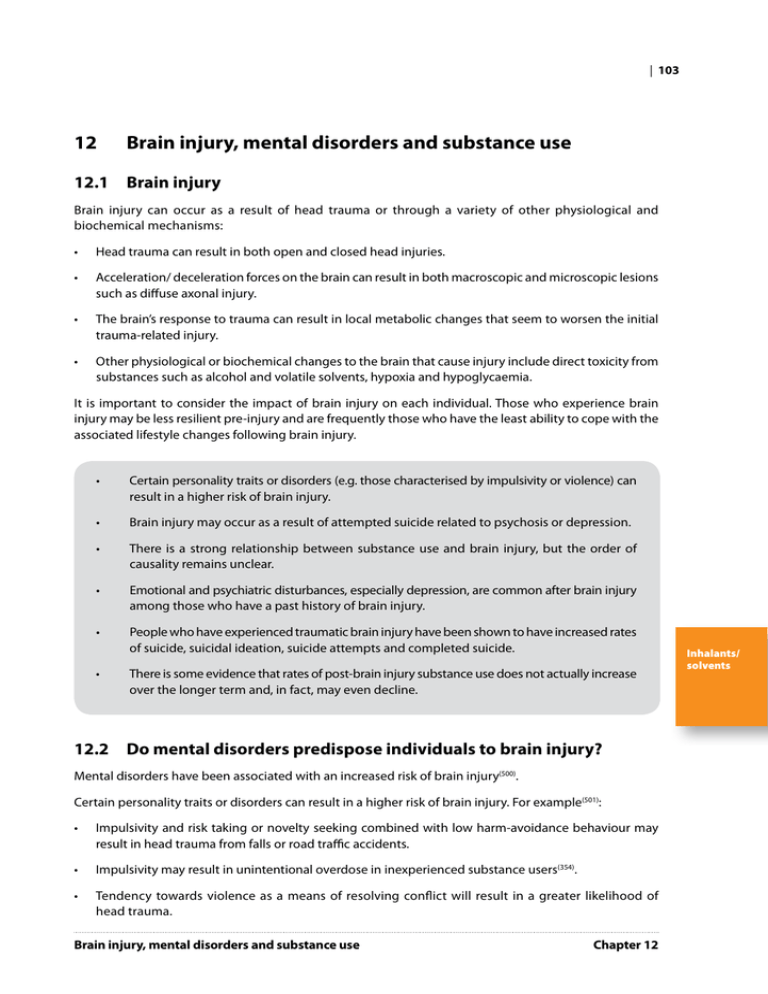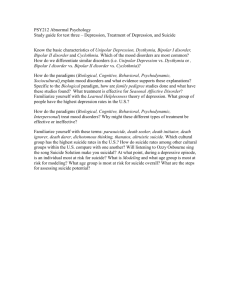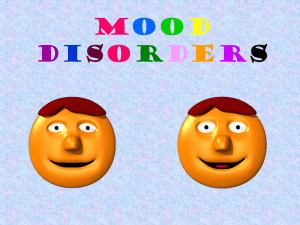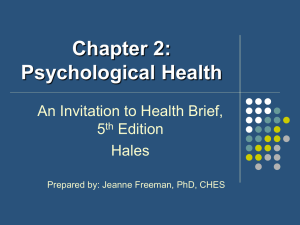12 Brain injury, mental disorders and substance use
advertisement

| 103 12 Brain injury, mental disorders and substance use 12.1 Brain injury Brain injury can occur as a result of head trauma or through a variety of other physiological and biochemical mechanisms: • Head trauma can result in both open and closed head injuries. • Acceleration/ deceleration forces on the brain can result in both macroscopic and microscopic lesions such as diffuse axonal injury. • The brain’s response to trauma can result in local metabolic changes that seem to worsen the initial trauma-related injury. • Other physiological or biochemical changes to the brain that cause injury include direct toxicity from substances such as alcohol and volatile solvents, hypoxia and hypoglycaemia. It is important to consider the impact of brain injury on each individual. Those who experience brain injury may be less resilient pre-injury and are frequently those who have the least ability to cope with the associated lifestyle changes following brain injury. • ertain personality traits or disorders (e.g. those characterised by impulsivity or violence) can C result in a higher risk of brain injury. • Brain injury may occur as a result of attempted suicide related to psychosis or depression. • T here is a strong relationship between substance use and brain injury, but the order of causality remains unclear. • Emotional and psychiatric disturbances, especially depression, are common after brain injury among those who have a past history of brain injury. • People who have experienced traumatic brain injury have been shown to have increased rates of suicide, suicidal ideation, suicide attempts and completed suicide. • T here is some evidence that rates of post-brain injury substance use does not actually increase over the longer term and, in fact, may even decline. 12.2 Do mental disorders predispose individuals to brain injury? Mental disorders have been associated with an increased risk of brain injury(500). Certain personality traits or disorders can result in a higher risk of brain injury. For example(501): • Impulsivity and risk taking or novelty seeking combined with low harm-avoidance behaviour may result in head trauma from falls or road traffic accidents. • Impulsivity may result in unintentional overdose in inexperienced substance users(354). • Tendency towards violence as a means of resolving conflict will result in a greater likelihood of head trauma. Brain injury, mental disorders and substance use Chapter 12 Inhalants/ solvents 104 | Brain injury may occur as a result of attempted suicide(502) related to psychosis or depression. Such suicide attempts may result in both head trauma from jumping from heights or intentional road crashes, through to drug overdose or poisoning-related direct toxicity(351, 354). 12.3 Does substance use predispose individuals to brain injury? Substance use (including alcohol, cannabis and other illicit substances) has been associated with brain injury. Up to 40% of individuals with a brain injury have been found to meet DSM-IV criteria for substance use disorders prior to the injury. Conversely, 68% of people with a substance use disorder have also been found to have had some sort of previous head injury(503, 504). While there is a strong relationship between substance use and brain injury, the order of causality remains unclear(504-506). Some debate also remains as to whether substance use or its severity is an actual predictor of brain injury(507, 508). The risk of brain injury as a result of increased impulsivity and risk taking or novelty seeking behaviour associated with underlying personality traits may be exacerbated by substance use. Combined with low harm avoidance, this increased impulsivity can result in head trauma from falls or accidents or unintentional overdose(2, 501). Substance dependence may result in attempted suicide due to the inability to cope with the negative consequences of such dependence(351, 501, 507, 509). Brain injury can also result from: • The direct effects of substances on the brain (e.g. frontal lobe dysfunction, cerebellar dysfunction). • Indirect effects such as hypertension resulting in stroke. • Secondary nutritional deficiencies such as thiamine deficiency resulting in Wernicke-Korsakoff syndrome. Patients with brain injury and alcohol use disorders have been shown to have significantly reduced grey matter volumes compared with brain injured patients without alcohol use disorders(508). The question is whether an initial brain injury predisposes people to an increased risk of subsequent alcohol or other substance-induced brain injury. 12.4 Does brain injury predispose individuals to mental disorders or to suicide? 12.4.1 Brain injury and mental disorders • Emotional and psychiatric disturbances are common following brain injury, with those who have a past history of brain injury being diagnosed with a significantly greater number of psychiatric disorders. This association seems to apply to those within the general population who have been identified as having had a head injury, as well as specific patient populations attending brain injury rehabilitation services(503, 506, 510, 511). • There is controversy as to whether pre-brain injury psychiatric morbidity is predictive of postpsychiatric morbidity(503, 504, 506, 511, 512). Some authors have postulated that individuals with no prebrain-injury psychiatric history may actually be more likely to develop post-brain injury psychiatric morbidity as they are likely to experience greater lifestyle changes(504). | 105 • The most frequently reported psychological challenge following brain injury is depression, with increased rates observed in individuals with a history of brain injury(503-505, 507, 512-516). • Occurrence of depression appears to be unrelated to severity of brain injury(504, 505, 512, 514, 516, 517). • Emotional disturbances following brain injury are disruptive both socially and occupationally and greatly affect daily functioning. Individuals who experience brain injury and depression have been observed to have generally poorer health outcomes (both physically and emotionally). They report higher levels of psychosocial dysfunction, psychological distress, neurobehavioural and cognitive dysfunction, including memory problems, and also have diminished life satisfaction(503, 506, 512, 516-518). • There is significant debate as to whether depression following brain injury is an episodic event and perhaps a normal phase in the overall initial adjustment to brain injury, or whether depression following brain injury is a long-term disorder. There appears to be a lack of correlation between the time after injury and the onset of depression. It is suggested that depression may occur at any time following brain injury with no clearly defined time line for resolution(504, 505, 512-516). • Resolution of depression following brain injury is accompanied by improvement in psychosocial functioning and perceived enhancement of one’s health(512). • Increased rates of anxiety following brain injury have also been observed, most commonly in people with PTSD, panic and OCD (e.g. writing and checking lists to compensate for cognitive disabilities)(503-506, 514). • Anxiety disorders are more likely to present as comorbidity with other Axis 1 diagnoses(503, 504, 512). • Comorbidity with mental disorders following brain injury is common, with more than one psychiatric disorder being identifiable in many individuals(503, 504, 512, 514). • The incidence of psychiatric disorders such as bipolar disorder and schizophrenia following brain injury more closely resembles that of the general population and is much less prevalent than depression and anxiety following brain injury(503, 504, 506, 514). Implications for management • Considering that mental disorders are common following brain injury, post-brain injury management should routinely include a psychological assessment. • Assessments should be undertaken at regular intervals following brain injury. It is important to try to establish what the mental health of the patient was prior to the injury and, particularly, to assess for the presence of anxiety and depression on an ongoing basis after the injury(504, 512, 514-516). • People who have experienced brain injury, as well as their families, should be made aware of the risk of experiencing a mental disorder in the future. This should be done whether or not the patient had mental health problems prior to the injury(504). • Individuals may present with hidden brain injury where the patient does not associate a connection between current problems and a previous brain injury. Brain injury-related symptoms such as problems with memory, attention, fatigue, the processing of multiple stimuli and impulse control may not be managed appropriately(506). Therefore, the possibility of brain injury in people presenting with non-specific cognitive type problems should be considered by the clinician. Brain injury, mental disorders and substance use Chapter 12 106 | • Early identification and treatment of depression following a brain injury may directly improve outcome and quality of life. Considering the effects of depression on cognitive impairment in those with brain injury(512, 516, 517), detection and appropriate management of depression may allow cognitive therapy approaches for brain injury to be more effective. • A number of motor, sensory and cognitive deficits overlap with the vegetative features of depression and may lead to over-diagnosis of depression. Similarly, there is significant symptom overlap with post-concussive syndrome(505). Feelings of hopelessness, worthlessness and anhedonia which are more specific features of depression that should be looked for by the clinician(516, 519). 12.4.2 Brain injury and suicide • People who have experienced traumatic brain injury have been shown to have increased rates of suicidal ideation, suicide attempts and completed suicide. This increased risk has been attributed to both the presence of a mental disorder and to the problems associated with adjustment to living with a brain injury(501, 505, 506, 510). • Individuals with brain injury employ a wide range of diverse methods to commit suicide(520). • Suicide following brain injury may be the result of multiple factors: the suddenness of onset of disability in previously healthy individuals, the global effects of disability, grief over the loss of a pre-injury lifestyle, the growing realisation of the effort involved in maintaining a similar level of functioning to that prior to brain injury, as well as a reduced level of neuropsychological coping mechanisms(510, 520). • Emotional and psychiatric disturbances and suicide ideation following brain injury have been shown to be significant predictors of suicide attempts(510). • Thoughts of hopelessness may be a stronger predictor of suicide ideation than the presence of depression alone(505, 510). • There is uncertainty about whether suicidal ideation is related to the severity of brain injury per se or whether it is related to the person’s assessment of the effects of the injury. • Pre-injury history of suicide attempts does not seem to confer additional increased risk post-injury(501, 510). • In parallel with the observations of the timing of depression following brain injury, the risk of suicide does not diminish but may fluctuate over time following brain injury(501, 505, 510). Years of disappointment can set in and the individual may have to face the confronting fact that they will not return to full premorbid functioning (501). Implications for management • The main clinical concern is the prevention of suicide(520). • There are increased numbers of individuals accessing GP services following brain injury; therefore, the GP is in an ideal position to monitor the patient’s mental state and suicide risk(519). • Individuals with brain injury may present for medical reasons and may not reveal suicidal ideation(519). | 107 • Assessment needs to involve seeking a history of pre-brain injury: – Suicidal behaviour. – Substance use. – Psychological disorders. • Assessment needs to include a history of post-brain injury suicide attempts as these are far more predictive of suicide risk following brain injury. • Post-brain injury management needs to include continuous and extended monitoring of warning signs for risk of suicide, including: – Symptoms of hopelessness and suicidal ideation(510, 519). – Signs that the individual is not adjusting to life following brain injury. • To prevent isolation, there is a need to continuously monitor the individual’s support networks, including social and familial. There is also a need to provide education to individual and support networks in relation to difficulties that may be encountered following brain injury(519, 520). • As individuals with brain injury may attempt suicide using a range of methods. It is important to reduce lethality where possible by: – Identifying the safest approach for prescribing, dispensing and administering medications(519). – Ensuring that people at risk have minimal access to weapons such as firearms(519). 12.5 Does brain injury predispose individuals to substance use? The relationship between brain injury and post-brain injury substance use (including alcohol, cannabis and other illicit substances) is still unclear and, as mentioned, causality remains uncertain. Those with a brain injury have been shown to have higher lifetime rates of substance use than those without(506). On the other hand, there is some evidence that rates of post-brain injury substance use does not increase(508, 514) and, in fact, may even decline(504). However, post-brain injury mood disorders are closely linked to post-brain injury alcohol use disorders and people with both have a poorer prognosis(508). Interestingly, several studies have shown increased rates of substance use within a year of brain injury that resolve in later years. It has been suggested that substance use may be used as an initial coping mechanism and may resolve itself as coping mechanisms improve over time(511, 514). There is also controversy as to whether the severity of brain injury is a predictor of post-brain injury substance use. Some patients who have relapsed back into substance use following brain injury have been observed to have significantly more frequent and more severe brain injuries than those who remained abstinent(504, 508). Substance dependent individuals with brain injury have more clinically-rated depressive symptoms and self-reported somatic symptoms and are more likely to attempt suicide(501, 507). Therefore, it is important to ensure that substance use is managed following brain injury. Brain injury, mental disorders and substance use Chapter 12 108 | Implications for management • In parallel to mental disorders after brain injury, there is a need for consumer-based education regarding long-term substance use risk after brain injury, regardless of the individual’s previous substance use history(504). • Substance use should be monitored along with indicators of mental disorders and suicide risk. The clinician should intervene if the substance use becomes problematic. 12.6 Does brain injury impact on treatment approaches to mental disorders and substance use? • The treatment of mental disorders following brain injury is not well understood. • I t is vital to actively manage mental disorders following brain injury as individuals with postbrain injury history of emotional distress and substance use are the most likely to attempt suicide. • Sertraline has been shown to be effective in treating depression following brain injury. • It is important to minimise side effects as brain-injured clients may not have the coping mechanisms to deal with the side effects of psychotropic medications. • CBT has been shown to be effective in managing acute stress disorder following mild brain injury. • level of substance use that may be regarded as ‘low risk’ in the general population may carry A a significantly higher risk for a person who has experienced a brain injury. • Pharmacotherapy treatments for substance use may also have a variable effect on individuals who have experienced brain injury. 12.6.1 Approaches to substance use Every brain injury affects individuals in different ways. It is difficult to predict the full extent of the injury and the effects it may have on different neurotransmitter and metabolic systems. The effect of continued substance use following brain injury is also difficult to predict. However, there is evidence that levels of dysfunction are worse in those who have had a history of pre-brain injury substance-use disorders, (for instance alcohol), who relapse following brain injury(508). In addition, a level of substance use that may be regarded as ‘low risk’ in the general population may carry a significantly higher risk for a person who has experienced a brain injury: • Individuals need to be counselled on the possible increased risk associated with substance use post-injury. • It is important to consider the variable cognitive abilities, insight and degree of impulse control when counselling the person who has experienced brain injury(512, 514, 516). These variables will influence the choice of psychological approaches to the person following brain injury. | 109 • Similarly, pharmacotherapy treatments for substance use may also have a variable effect on individuals who have experienced brain injury due to altered metabolic or neurotransmitter pathways(521). Pharmacotherapies that may be effective in one individual may not be effective in another who has experienced brain injury. • As the brain recovers following injury, the effectiveness of pharmacotherapies for substance use and the severity of side effects may change over time within the one individual. • The sedative effects of benzodiazepines used for acute symptomatic relief during substance withdrawal and opioids such as methadone may be exacerbated in people with brain injury. Therefore, they may increase the risk of overdose. 12.6.2 Approaches to mental disorders Available evidence on the treatment of mental disorders following brain injury is scarce. Studies are generally uncontrolled and have mixed results. An overlap between brain injury sequelae and the features of mental disorder will inevitably have implications for diagnosis and treatment planning. Treatment is usually based on what works best from clinical experience(522). • Clinicians need to carefully assess individuals with mental disorders for past history of brain injury(506). Comorbid brain injury is a frequent problem for people with a mental disorder. Their risk of self harm is higher than for those people without comorbid brain injury. • People with both a mental disorder and a brain injury may need additional cognitive and psychotherapeutic interventions that are not usually available to people who only have psychiatric diagnoses. • In a similar fashion to management of individuals with substance use issues following brain injury, pharmacotherapy-based treatments for individuals with mental disorders and brain injury need to be assessed on an individual basis. The risk–benefit balance of drug-based treatments may be quite different in those with brain injury. There may be significant variation from one person to another due to altered metabolic or neurotransmitter pathways(521). • In addition, the risk–benefit balance may, in fact, change over time within the individual as the healing process continues and the brain recovers from injury. Therefore, a medication that may have been effective in relieving depressive symptoms immediately following brain injury may not be effective after an extended period of time, or vice versa. This would account for the overall inconsistencies observed in the treatment effectiveness of psychopharmacological drugs following brain injury(523). • There is also evidence that medications administered to control mental disorders following brain injury may, depending on their mechanisms of action and timing of administration, have a neuroprotective effect. However, they may also slow the recovery process(524). • It is important to minimise side effects as brain-injured clients may not have the coping mechanisms to deal with the side effects of psychotropic medications. • It is vital to actively manage mental disorders following brain injury as individuals with post-brain injury history of emotional distress and substance use are the most likely to attempt suicide(519). Resolution of depression (whether spontaneous or in response to treatment) following brain injury is accompanied by improvement in psychosocial functioning and perceived enhancement of one’s Brain injury, mental disorders and substance use Chapter 12 110 | health(512). Active treatment of depression following brain injury significantly improves emotional functioning and general mental health, physical functioning, sleep and vitality, and social, work and family functioning. Such treatment may also reduce unexplained somatic symptoms, perception of illness severity and disability, and subsequent illness behaviour(500). • With doses similar to those used in the general population, sertraline (SSRI) has been shown to be effective in treating depression following brain injury***(523, 525, 526): –Decreases in overall psychological distress have been observed along with minimal side effects***(523, 525). This is promising, as individuals with brain injury do not usually present with symptoms that fall into strict DSM-IV criteria but with an array of symptoms such as depression and anxiety (519, 525). –Similarly, sertraline has been shown to significantly decrease the burden of post-concussive symptoms*(500). –If sertraline decreases psychological distress across many domains and minimises the impact of post-concussive syndrome, then it may not be as important to make a strict diagnosis (which may not be possible anyway) following brain injury. In addition, screening for and treating depression in patients with persistent post-concussive symptoms may be an effective way to decrease unnecessary suffering and reduce excess disability(500). • The sedative effects of antipsychotics, mood stabilisers, benzodiazepines and sedative antidepressants such as tricyclics may be exacerbated in people with brain injury. Therefore, they may increase the risk of overdose. • CBT has been shown to be effective in managing acute stress disorder following mild brain injury**** (527). However, the cognitive capacities of the individual need to be considered before undertaking this line of treatment. For further information please consult: Alcohol related brain injury: A guide for general practitioners and other health workers(528) Clinical practice guidelines for the care of people living with traumatic brain injury in the community(529): http://www.lifetimecare.nsw.gov.au/default.aspx?MenuID=49 Brain Injury Australia: http://www.braininjuryaustralia.org.au/






